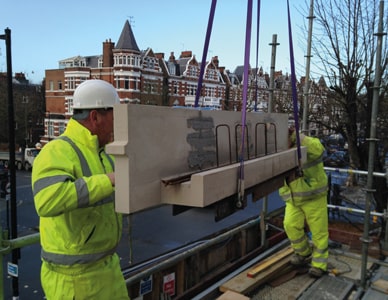BS 1217 ‘Cast stone – Specification’ Standard and UKCSA Specification
In the UK the national standard for cast stone is BS 1217 Cast stone – Specification. However, the national trade association for manufacturers of cast stone products is the United Kingdom Cast Stone Association (UKCSA), which publishes its own specification for members to follow. While the British standard is longer and contains more detail, the UKCSA specification differs significantly in that it calls for a higher compressive strength. Architects and structural engineers therefore need to be aware of this difference and take care to specify the specifications to which cast stone units must be manufactured.
At the time of writing, the current version of the British Standard is BS1217:2008 – and note that BS ISO 1217 and BS EN 1217 are completely different standards; the former relates to displacement compressors and the latter to materials and articles in contact with foodstuffs! Interestingly, BS 1217 has remained current despite most British standards for masonry units being superseded by European standards in the BS EN 771 series.
BS 1217 comprises ten clauses three annexes and a bibliography. In addition, the Foreword explains who prepared the standard, which standard it supersedes, and makes references to the recently published standards BS EN 771-5 (Specification for masonry units. Manufactured stone masonry units) and BS EN 845-2 (Specification for ancillary components for masonry. Lintels). Within clause 1, Scope, there are also references to BS 5642-1 (Sills and copings. Specification for window sills of precast concrete, cast stone, clayware, slate and natural stone) and BS 5642-2 (Sills and copings. Specification for copings of precast concrete, cast stone, clayware, slate and natural stone), and clause 2, Normative references, cites BS 1881-208 (Testing concrete. Recommendations for the determination of the initial surface absorption of concrete), BS EN 12390-2 (Testing hardened concrete. Making and curing specimens for strength tests) and BS EN 12390-3 (Testing hardened concrete. Compressive strength of test specimens). All of these standards are listed in the bibliography, and this also adds one more standard, BS EN 1991-1-1 (Eurocode 1. Actions on structures. General actions. Densities, self-weight, imposed loads for buildings) – and bear in mind that the UK National Annex to this Eurocode is NA to BS EN 1991-1-1:2002. Users of BS 1217 therefore need to be sure that they are complying with all relevant British, not just the caststone standard BS 1217.
Turning now to the technical specifications, Clause 4 of BS 1217 addresses the needs of two-part mix units – stating a minimum face mix thickness of 20mm for visual faces and the need for a bond (via mechanical keying or inter-diffusion) between the facing and backing mixes.
Cast stone units often incorporate reinforcement, and this is covered in some detail by clause 5. For example, the standard cites the minimum cover required for untreated steel, galvanised steel and non-corroding reinforcement materials.
Clause 6 is one of the most important parts of BS 1217, as it lays down the requirements for compressive strength as measured by crushing test cubes of 100 or 150mm in size. The average strength of any three test cubes must be not less than 25.0 MPa and the strength of any single cube must not be less than 20 MPa. This is where the UKCSA standard differs significantly from BS 1217, as the corresponding figures in the UKCSA standard are 35 MPa and 28 MPa. In other words, cast stone units manufactured in accordance with the UKCSA standard can be expected to be around 40 per cent stronger than those manufactured only to BS 1217.
Although clause 7 covers the surface finish of cast stone units, it merely states that the colour and textural finish of the visual face are to be the subject of a contractual agreement based on samples and/or mock-ups representative of the planned production (and the UKCSA specification is similar).
Clause 8, Tolerances, includes a table of tolerances for different linear dimensions, and also provides a tolerance for the flatness of plane surfaces. There is no mention of tolerances for curved surfaces, but the standard notes that tighter tolerances can be agreed between the purchaser and manufacturer.
Weathering is covered by clause 9, which provides specifications for two alternative tests: the capillary absorption test (CAT) and the initial surface absorption test (ISAT). Annex A (which is only informative) gives more information about the apparatus and test methods for the CAT, and Annex B suggests that CAT conformity is usual for semi-dry cast stone products and conformity with both CAT and ISAT is usual for wet-cast units.
Clause 10, Marking, lists the information that must be included on the delivery note, drawings, invoice or supplier’s certificate provided with each consignment of cast stone units.
Annex A, CAT weathering, has already been mentioned, and Annex B, General notes for guidance, covers topics such as manufacturing variations, weathering, testing and curing, and there is a table comparing the properties of semi-dry cast and wet cast units. Annex C provides guidance on slenderness ratios and includes diagrams to show how circles should be inscribed or superscribed on typical sections in order to calculate the slenderness ratio.
As well as the similarities and differences between BS 1217 and the UKCSA specification mentioned above, it is worth noting that the UKCSA specification also has requirements for mortar (to BS 5628-3:2005) and joints (flush pointed, 6mm or 10mm widths).
Neither BS 1217 nor the UKCSA specification covers everything that might be required from cast stone units, so architects and specifiers are recommended to work with both documents, which means selecting a supplier that is a full member of UKCSA. In addition, it is the supplier should be consulted at an early stage in the project so that any additional requirements can be included in the agreed specification.
To help architects and specifiers maximise the benefits of cast stone, Procter Cast Stone & Concrete Product has published Understanding Cast Stone, a Guide to Cast Stone Products for Architects and Specifiers. This guide and the UKCSA specification are available from the Downloads section of the website or request copies by telephoning us or emailing info@proctercaststone.co.uk Copies of BS 1217 are available from BSI.



